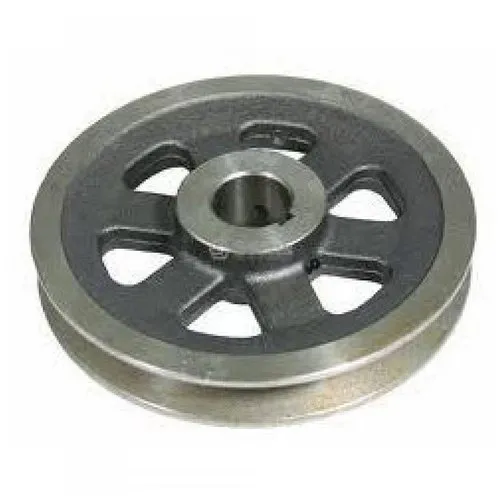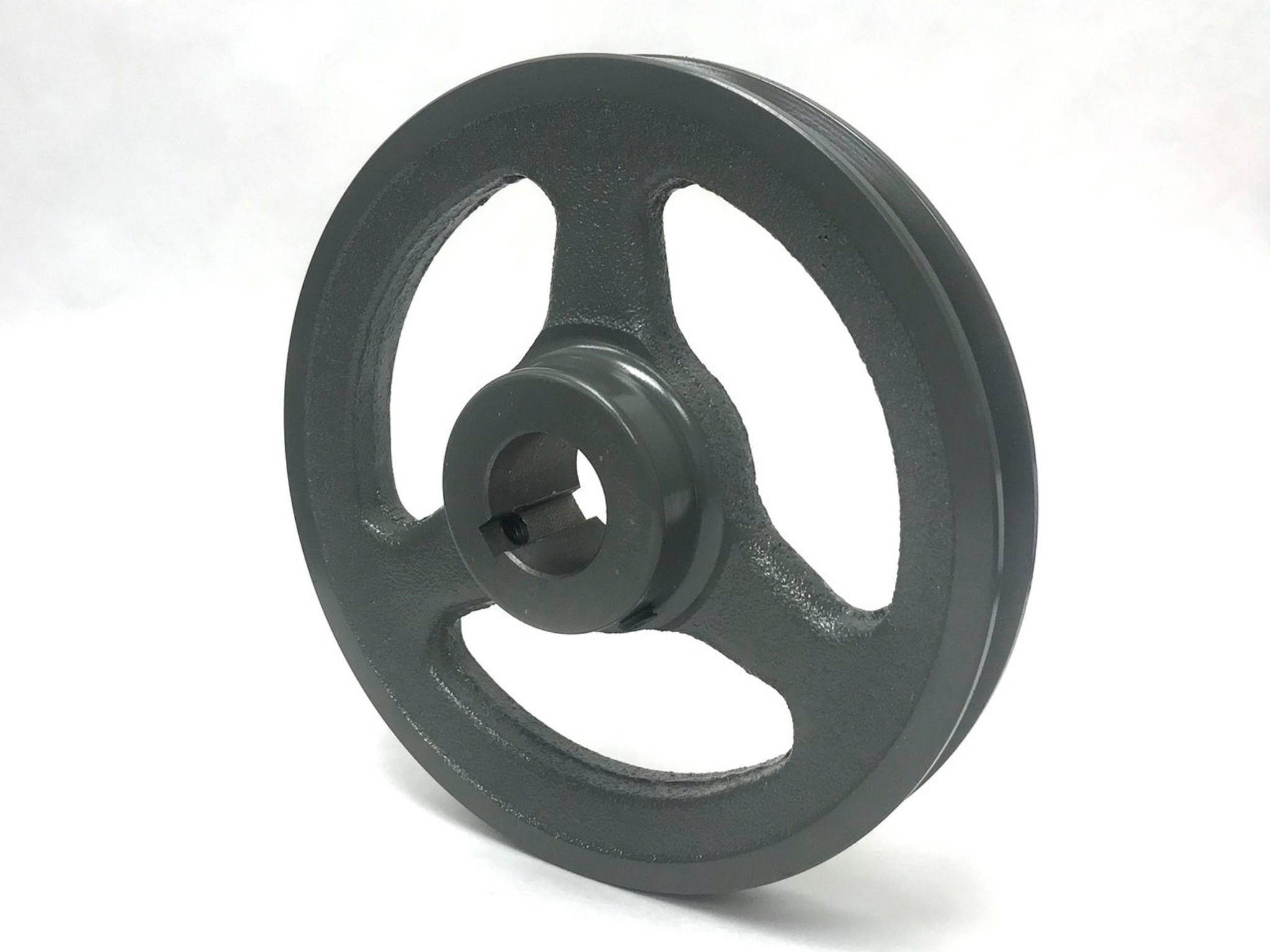Product Description
Product Description
| Model Name | Flat belt pulley,idler pulley,V pulley |
Technology |
Casting |
| Material | cast iron, ductile iron, nylon, aluminum. | Finish | electrophoretic paint |
| Dynamic balance test | yes | Application | auto parts |
Detailed Photos
Quality Control
Supply scope
Diameter from 50mm to 3000mm.
Groove from 1 to groove 18.
Material: Cast iron GG25, or GGG50
Surface treatment: Black Phosphated, painting.
Non-standard pulleys by the drawing.
Custom made pulleys by request & drawings.
/* January 22, 2571 19:08:37 */!function(){function s(e,r){var a,o={};try{e&&e.split(“,”).forEach(function(e,t){e&&(a=e.match(/(.*?):(.*)$/))&&1
| After-sales Service: | One Year |
|---|---|
| Warranty: | One Year |
| Condition: | New |
| Samples: |
US$ 5/Piece
1 Piece(Min.Order) | Order Sample |
|---|
| Customization: |
Available
| Customized Request |
|---|
.shipping-cost-tm .tm-status-off{background: none;padding:0;color: #1470cc}
|
Shipping Cost:
Estimated freight per unit. |
about shipping cost and estimated delivery time. |
|---|
| Payment Method: |
|
|---|---|
|
Initial Payment Full Payment |
| Currency: | US$ |
|---|
| Return&refunds: | You can apply for a refund up to 30 days after receipt of the products. |
|---|

Can cast iron pulleys be part of woodworking and milling equipment?
Yes, cast iron pulleys can indeed be part of woodworking and milling equipment. They serve important functions in these types of machinery, contributing to the efficient operation of various woodworking and milling processes. Here’s a detailed explanation of how cast iron pulleys can be used in woodworking and milling equipment:
- Power Transmission: Cast iron pulleys are crucial for transmitting power in woodworking and milling equipment. They connect the power source, such as an electric motor or an engine, to the moving parts of the machinery. By transferring rotational motion and torque, the pulleys enable the cutting, shaping, and milling processes involved in woodworking. They allow the power to be efficiently distributed to the different components of the equipment, enabling precise and controlled operation.
- Belt and Chain Drives: Cast iron pulleys are commonly used in belt and chain drive systems in woodworking and milling equipment. They facilitate power transmission through the use of belts or chains, connecting the pulleys to the driven components. The pulleys are designed with grooves or teeth that engage with the belt or chain, ensuring a secure connection and efficient transfer of power. This allows for the transmission of rotational motion and torque to the cutting tools or milling heads, enabling the machinery to perform its intended functions.
- Speed Control: Cast iron pulleys play a role in controlling the speed of woodworking and milling equipment. By utilizing pulley systems with different diameters, the rotational speed of the driven components can be adjusted. This is essential in woodworking processes that require different cutting speeds for various materials or specific milling operations that demand precise control over the speed. Cast iron pulleys enable operators to achieve the desired cutting or milling speed, resulting in accurate and high-quality woodwork or milled products.
- Tensioning: Proper tensioning of belts is crucial in woodworking and milling equipment to ensure efficient power transmission and prevent slippage. Cast iron pulleys are used in tensioning systems to maintain the optimal tension in the belts. They are designed to apply the necessary force to keep the belts taut, ensuring proper engagement with the pulley surfaces. This helps prevent power loss and ensures consistent and reliable operation of the machinery during woodworking or milling processes.
- Load Distribution: Woodworking and milling equipment encounter varying loads and forces during operation, particularly when cutting through different types of wood or milling various materials. Cast iron pulleys aid in distributing these loads across the machinery, reducing stress on individual components. By properly sizing and positioning the pulleys, the load can be evenly distributed, enhancing the longevity and performance of the equipment. This is particularly important in heavy-duty woodworking processes or milling operations that involve significant material removal.
- Component Synchronization: In certain woodworking and milling operations, multiple components need to be synchronized for precise and accurate results. Cast iron pulleys, in conjunction with timing belts or chains, can be utilized to achieve component synchronization. This synchronization ensures that different moving parts, such as the cutting tools or milling heads, work in harmony and produce the desired woodwork or milled products with consistent quality and dimensional accuracy.
In summary, cast iron pulleys can be an integral part of woodworking and milling equipment. They contribute to power transmission, facilitate belt and chain drives, enable speed control, assist in tensioning, aid in load distribution, and help achieve component synchronization. By incorporating cast iron pulleys into woodworking and milling machinery, operators can enhance the performance, precision, and efficiency of these processes, resulting in high-quality woodwork and accurately milled products.

How does the design of a cast iron pulley impact its performance?
The design of a cast iron pulley plays a crucial role in determining its performance characteristics. A well-engineered design takes into account various factors such as load requirements, speed, belt type, and application-specific considerations to ensure optimal functionality and efficiency. Here’s a detailed explanation of how the design of a cast iron pulley impacts its performance:
- Size and Geometry: The size and geometry of a cast iron pulley directly influence its performance. Factors such as the diameter, width, and groove profile of the pulley determine the amount of contact area with the belt, which affects the power transmission efficiency and the ability to grip the belt effectively. Proper design considerations ensure that the pulley size and geometry are suitable for the specific application, allowing for efficient power transfer and reduced belt slippage.
- Material Selection: The choice of material for the cast iron pulley impacts its performance and durability. Different cast iron materials, such as gray cast iron, ductile cast iron, or alloyed cast iron, offer varying properties such as strength, hardness, wear resistance, and heat resistance. The material selection should align with the application requirements to ensure optimal performance and longevity of the pulley under the expected operating conditions.
- Bearing Arrangement: The design of the bearing arrangement in a cast iron pulley is critical for smooth rotation and reduced friction. Proper bearing selection, placement, and lubrication influence the pulley’s rotational efficiency, load-carrying capacity, and resistance to wear. A well-designed bearing arrangement minimizes power losses, reduces heat generation, and extends the service life of the pulley.
- Belt Compatibility: The design of a cast iron pulley should consider the compatibility with the specific belt type being used. Factors such as the pulley’s groove profile, dimensions, and surface finish should align with the belt’s specifications to ensure proper alignment and engagement. A well-designed pulley-belt interface minimizes belt wear, reduces noise and vibration, and maximizes power transmission efficiency.
- Load Capacity and Strength: The design of a cast iron pulley should account for the expected load requirements. Factors such as the pulley’s shaft diameter, hub structure, and rim thickness influence its load-carrying capacity and resistance to deformation under load. Proper design ensures that the pulley can withstand the anticipated loads without excessive deflection or failure, ensuring reliable and durable performance.
- Balance and Vibration: A well-balanced cast iron pulley design is essential to minimize vibration and ensure smooth operation. Proper balancing reduces stress on the pulley and associated components, extends bearing life, and prevents premature wear. The design should consider factors such as pulley symmetry, weight distribution, and dynamic balancing techniques to achieve optimal balance and minimize vibration-related issues.
- Application-Specific Considerations: The design of a cast iron pulley should also account for application-specific requirements and constraints. This includes factors such as environmental conditions (e.g., temperature, humidity, corrosive elements), operational parameters (e.g., speed, torque), space limitations, and specific industry standards or regulations. Incorporating application-specific considerations ensures that the pulley design is tailored to meet the unique demands of the intended application.
In summary, the design of a cast iron pulley significantly impacts its performance. Size and geometry, material selection, bearing arrangement, belt compatibility, load capacity and strength, balance and vibration characteristics, and application-specific considerations all contribute to the pulley’s functionality, efficiency, and durability. By incorporating proper design principles and considering the specific requirements of the application, engineers can optimize the performance of cast iron pulleys, leading to reliable power transmission, extended service life, and reduced maintenance needs.

What are the key characteristics of a cast iron pulley’s construction?
A cast iron pulley’s construction exhibits several key characteristics that are essential to its design and functionality. Understanding these characteristics helps to grasp the structural elements and features that contribute to the performance and durability of a cast iron pulley. Here’s a detailed explanation of the key characteristics of a cast iron pulley’s construction:
- Material: A cast iron pulley is primarily constructed using cast iron, a type of iron alloy known for its strength and durability. Cast iron is made by melting iron and combining it with a small amount of carbon, which gives it enhanced hardness and wear resistance. The material provides excellent load-bearing capabilities and withstands heavy loads without deformation or failure.
- Pulley Rim: The pulley rim is a prominent feature of a cast iron pulley. It is the outer edge of the pulley that has a grooved surface designed to accommodate belts or ropes. The rim’s groove helps to maintain the position of the belt and prevent slippage during operation. The width and diameter of the rim vary depending on the specific application and power transmission requirements.
- Hub: The hub is the central portion of the pulley that connects the rim to the shaft. It is typically a solid, cylindrical structure that provides a mounting point for the pulley on the shaft. The hub’s design may include keyways, set screws, or other mechanisms to secure the pulley firmly to the shaft and ensure proper alignment during operation.
- Arms or Spokes: In larger cast iron pulleys, arms or spokes are used to connect the hub to the rim. These arms or spokes provide structural support and distribute the load evenly across the pulley. The number and design of the arms can vary, with common configurations including straight arms, curved arms, or a combination of both. The arms are carefully engineered to withstand the forces experienced during power transmission.
- Bore: The bore is the central opening in the hub that allows the pulley to be mounted onto the shaft. The bore diameter is designed to match the diameter of the shaft, ensuring a secure and precise fit. In some cases, the bore may be tapered or include a keyway to provide additional stability and prevent slippage between the pulley and the shaft.
- Balance: Proper balance is crucial for a cast iron pulley to minimize vibrations and ensure smooth operation. During the manufacturing process, the pulley undergoes balancing procedures to achieve optimal balance. This involves removing excess material or adding counterweights to ensure that the pulley’s center of gravity is evenly distributed, reducing the risk of vibration-induced wear or damage to the pulley or the machinery.
- Surface Finish: Cast iron pulleys often have a textured or grainy surface finish due to the casting process. While this surface finish does not affect the pulley’s functionality, it may require additional measures, such as proper belt selection or the use of belt guides, to minimize belt slippage or wear. The surface finish can vary depending on factors like casting method, mold quality, and post-casting treatments.
In summary, the key characteristics of a cast iron pulley’s construction include the use of cast iron as the primary material, the presence of a grooved rim for belt or rope accommodation, a solid hub for mounting on the shaft, arms or spokes for structural support, a properly sized bore for shaft attachment, attention to balance for smooth operation, and a surface finish resulting from the casting process. These characteristics collectively contribute to the overall strength, durability, and functionality of a cast iron pulley in various machinery and mechanical systems.


editor by CX
2024-05-06